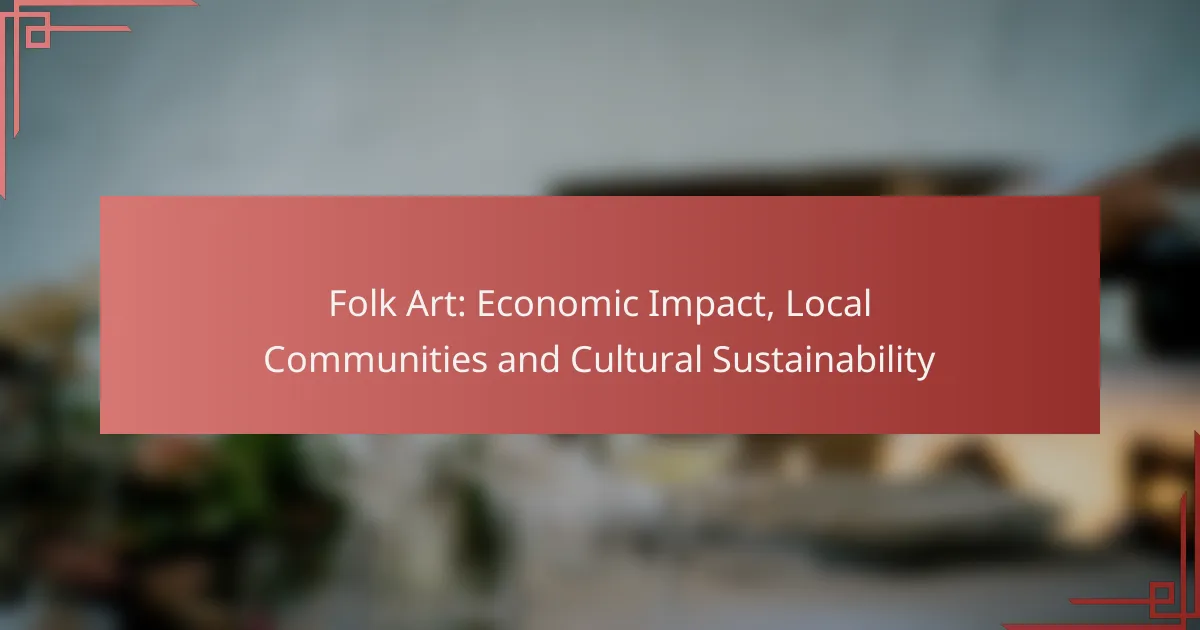Folk art today embodies a dynamic fusion of traditional practices and modern influences, showcasing artists’ commitment to sustainability and community engagement. This evolution not only enriches contemporary craft practices but also emphasizes personal expression through vibrant colors and diverse cultural narratives. As artists revive age-old techniques and integrate new technologies, the landscape of folk art continues to thrive and transform.
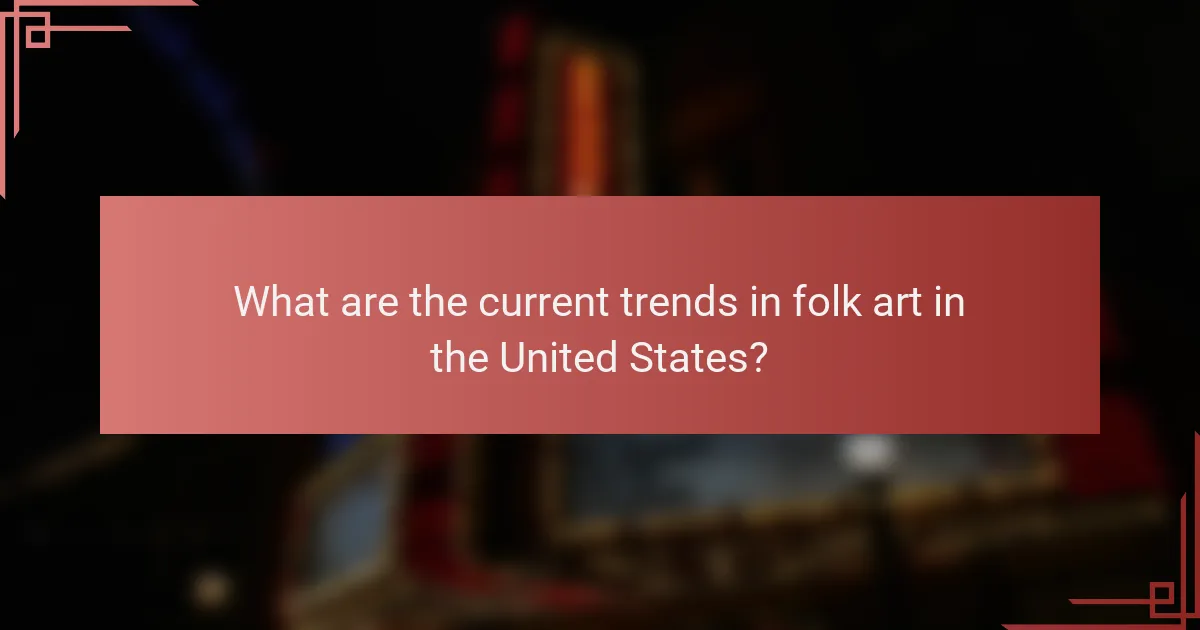
What are the current trends in folk art in the United States?
Current trends in folk art in the United States reflect a blend of traditional practices and contemporary influences. Artists are increasingly focusing on sustainability, integrating technology, reviving traditional techniques, and engaging in community-driven projects.
Emphasis on sustainability
Sustainability is a key trend in modern folk art, with many artists prioritizing eco-friendly materials and practices. This includes using recycled or natural materials, which not only reduces waste but also connects the artwork to the environment.
For example, artists might create pieces from reclaimed wood or upcycled textiles, promoting a message of environmental responsibility. This trend resonates with audiences who value sustainability and seek to support artists who share these principles.
Integration of technology
Technology is increasingly influencing folk art, allowing artists to explore new mediums and reach wider audiences. Many folk artists are using digital tools for design, production, and promotion, which can enhance their creative processes and visibility.
Examples include the use of social media platforms to showcase artwork, as well as digital fabrication techniques like 3D printing. This integration helps artists blend traditional craftsmanship with modern innovation, appealing to a tech-savvy audience.
Revival of traditional techniques
There is a growing interest in reviving traditional folk art techniques, as artists seek to honor cultural heritage while adapting these methods for contemporary expression. This revival often involves learning from older generations and incorporating historical practices into new works.
For instance, techniques such as quilting, pottery, or wood carving are being reinterpreted by modern artists, who may add personal or modern twists. This trend not only preserves cultural traditions but also enriches the folk art landscape with diverse influences.
Community-driven projects
Community engagement is a significant aspect of current folk art trends, with many artists collaborating on projects that involve local participation. These initiatives often aim to foster a sense of belonging and collective identity within communities.
Examples include mural projects, community craft fairs, and workshops that invite local residents to contribute their skills and stories. Such projects not only beautify public spaces but also strengthen community ties and promote cultural exchange.
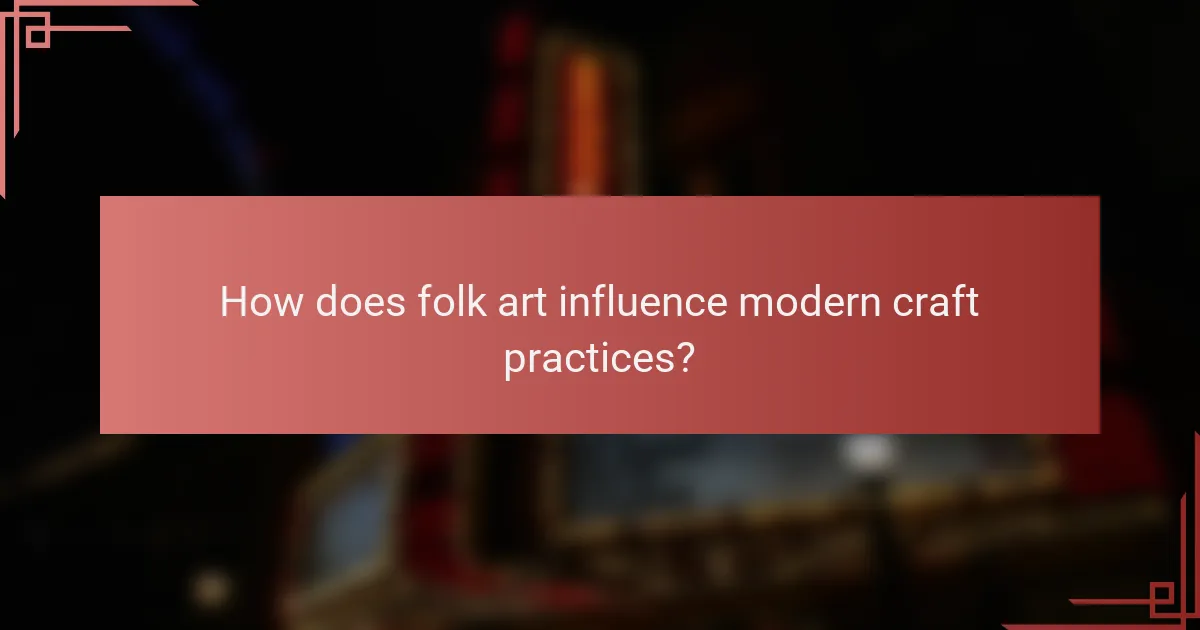
How does folk art influence modern craft practices?
Folk art significantly shapes modern craft practices by infusing traditional techniques and cultural narratives into contemporary works. This influence manifests in various ways, from aesthetic choices to material usage, enriching the craft landscape with diverse perspectives and methods.
Inspiration for contemporary artists
Contemporary artists often draw inspiration from folk art to explore themes of identity, heritage, and community. By incorporating elements from traditional folk art, such as motifs and storytelling techniques, artists create works that resonate on both personal and cultural levels.
For example, an artist might reinterpret a traditional textile pattern in a modern installation, bridging the gap between past and present. This approach not only honors the original craft but also invites new interpretations and dialogues.
Use of traditional materials
Many modern craftspeople utilize traditional materials, such as clay, wood, and natural fibers, to maintain authenticity in their work. These materials often carry historical significance and connect the artist to their cultural roots, enhancing the narrative of the piece.
Incorporating local materials can also support sustainable practices, as artisans often source them from their immediate environment. For instance, using locally harvested wood not only reduces transportation costs but also promotes regional craftsmanship.
Collaboration with artisans
Collaboration between contemporary artists and traditional artisans fosters a rich exchange of techniques and ideas. Such partnerships can lead to innovative creations that respect and elevate folk art traditions while appealing to modern audiences.
For example, a contemporary designer might work with a skilled weaver to create a new line of textiles that blend traditional weaving methods with modern aesthetics. This synergy not only preserves the craft but also introduces it to new markets, ensuring its continued relevance.
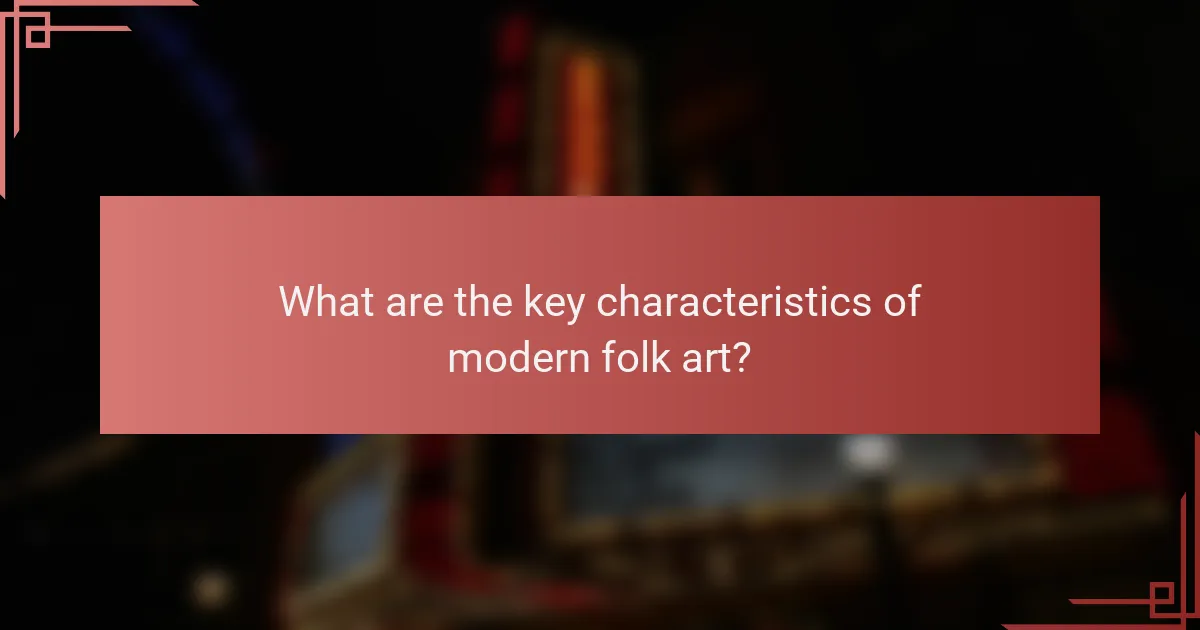
What are the key characteristics of modern folk art?
Modern folk art is characterized by its emphasis on personal expression, vibrant colors, and a blend of cultural influences. These elements reflect the artist’s background and experiences, making each piece unique and relatable.
Personal storytelling
Personal storytelling is a central theme in modern folk art, allowing artists to convey their life experiences, cultural heritage, and emotions through their work. This narrative approach often transforms everyday objects into powerful symbols of identity and community.
Artists may incorporate elements from their upbringing, family traditions, or significant life events, creating a connection with viewers. For example, a piece might depict a family gathering or a local festival, inviting the audience to share in the artist’s memories.
Use of vibrant colors
The use of vibrant colors is a hallmark of modern folk art, capturing attention and evoking emotions. Bright hues often symbolize joy, celebration, or cultural significance, making the artwork visually striking and engaging.
Artists typically choose colors based on personal preference or cultural meanings. For instance, reds and yellows may represent happiness in some cultures, while blues and greens might signify tranquility. This color palette enhances the storytelling aspect, drawing viewers into the narrative.
Mix of cultural influences
A mix of cultural influences is prevalent in modern folk art, reflecting the diverse backgrounds of contemporary artists. This blending of styles and techniques creates unique artworks that resonate with a wide audience.
Artists often draw inspiration from various traditions, integrating motifs, patterns, and materials from different cultures. For example, an artist might combine traditional African textile patterns with European painting techniques, resulting in a fresh and innovative piece. This fusion not only showcases the artist’s versatility but also promotes cultural appreciation and dialogue.

How has folk art evolved over the last decade?
Folk art has seen significant evolution in the past decade, marked by a blend of traditional techniques with contemporary themes and technologies. This transformation is largely driven by increased accessibility and visibility, allowing artists to reach wider audiences and collaborate across disciplines.
Increased visibility through social media
Social media platforms have revolutionized how folk artists showcase their work, enabling them to connect with global audiences. Artists can share their creative processes, engage with followers, and promote their pieces, leading to greater appreciation and demand for folk art.
Platforms like Instagram and Pinterest have become essential for artists to build their brands, often resulting in increased sales and commissions. The visual nature of these platforms allows for vibrant displays of craftsmanship, attracting both collectors and casual admirers.
Emergence of folk art fairs
Folk art fairs have gained popularity, providing artists with opportunities to display their work in person and connect directly with buyers. These events often celebrate local culture and craftsmanship, fostering community engagement and support for artisans.
Many fairs now feature a mix of traditional and contemporary folk art, showcasing diverse styles and techniques. Participating in these fairs can enhance an artist’s visibility and provide valuable networking opportunities within the art community.
Cross-disciplinary collaborations
Collaboration between folk artists and practitioners from other fields, such as design, fashion, and technology, has become increasingly common. These partnerships often result in innovative projects that blend traditional folk art with modern aesthetics, appealing to a broader audience.
For example, some artists are incorporating digital elements into their work, creating interactive installations that engage viewers in new ways. This cross-pollination of ideas not only enriches the folk art scene but also helps preserve traditional techniques by reinterpreting them for contemporary contexts.

What are the prerequisites for participating in folk art communities?
To engage in folk art communities, individuals typically need a basic understanding of local traditions and a willingness to share their knowledge with others. These prerequisites foster collaboration and the preservation of cultural heritage.
Understanding of local traditions
A deep appreciation for local traditions is essential for anyone looking to participate in folk art communities. This understanding often includes knowledge of the history, techniques, and materials unique to the region. For instance, someone interested in Appalachian crafts should familiarize themselves with the specific weaving patterns and natural dyes used in the area.
Engaging with local artisans and attending workshops can enhance this understanding. Many communities offer classes or events that highlight traditional practices, allowing newcomers to learn directly from experienced artists. This hands-on experience is invaluable for grasping the nuances of local folk art.
Willingness to share knowledge
A willingness to share knowledge is crucial for fostering a collaborative environment in folk art communities. This sharing can take many forms, from teaching workshops to participating in group projects. By exchanging skills and techniques, community members can enrich their collective artistic practice.
Moreover, sharing knowledge helps preserve cultural practices that might otherwise fade away. For example, if a member of a folk art community has expertise in pottery, they can teach others about traditional firing methods, ensuring that these techniques continue to thrive. This reciprocity strengthens the community and enhances the overall quality of the art produced.
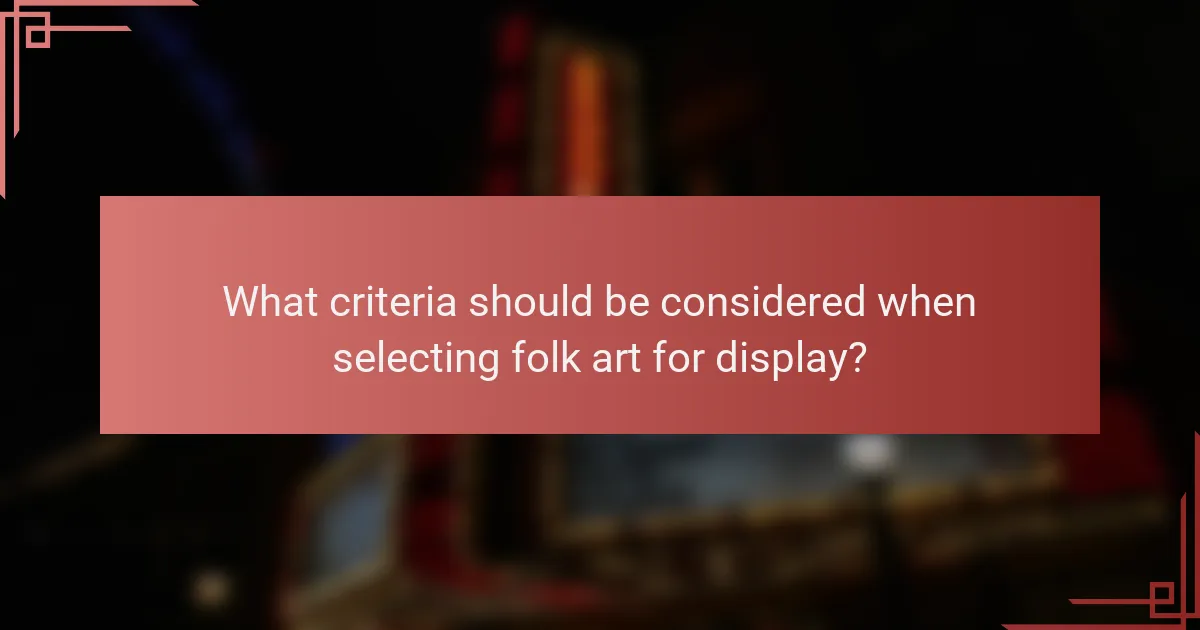
What criteria should be considered when selecting folk art for display?
When selecting folk art for display, consider factors such as authenticity, cultural significance, and aesthetic appeal. These criteria help ensure that the chosen pieces resonate with the intended audience and reflect the rich traditions from which they originate.
Authenticity of the piece
Authenticity is crucial when selecting folk art, as it signifies the piece’s genuine connection to its cultural roots. Look for works created by artisans who are part of the tradition, as their skills and techniques often embody the essence of the art form.
To assess authenticity, consider the materials used, the methods of creation, and the artist’s background. For example, traditional textiles made from local fibers and dyed with natural pigments are often more authentic than mass-produced replicas.
Additionally, seek documentation or provenance that traces the piece’s history. Certificates of authenticity or information about the artist can enhance the credibility of the work and assure potential buyers of its legitimacy.


